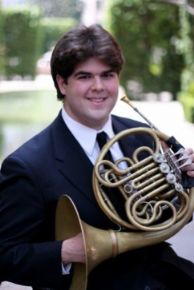|
Symphony
SRS SEASON ENDS WITH RESOUNDING TA-TA-TA-BANG
by Terry McNeill
Sunday, June 1, 2025
Symphony
YOUTHFUL VIRTUOSITY ON DISPLAY AT USO'S MAY CONCERTS
by Peter Lert
Saturday, May 17, 2025
Symphony
MYSTICAL PLANETS AND LIVELY GERSHWIN ORTIZ AT FINAL SRS CONCERT
by Peter Lert
Sunday, May 4, 2025
Symphony
VSO'S CONCERT MUSIC OF TIME, MUSIC OF PLACE
by Peter Lert
Sunday, April 27, 2025
Choral and Vocal
VOCAL ELEGANCE AND FIRE AT THE 222'S RECITAL APRIL 26
by Pamela Hicks Gailey
Saturday, April 26, 2025
CANTIAMO SONOMA SINGS AN INSPIRED GOOD FRIDAY MOZART REQUIEM CONCERT
by Pamela Hicks Gailey
Friday, April 18, 2025
DRAMATIC SHOSTAKOVICH SYMPHONY CLOSES PHILHARMONIC'S 25TH SEASON
by Terry McNeill
Sunday, April 13, 2025
LARGE COLLEGE OF MARIN AUDIENCE GREETS STOPHER ARTISTRY
by Terry McNeill
Saturday, April 5, 2025
Chamber
FRISSON DELIVERS SHIVERS OF DELIGHT
by Abby Wasserman
Sunday, March 30, 2025
OLD AND MOSTLY NEW IN SRS MARCH CONCERT IN WEILL
by Peter Lert
Saturday, March 22, 2025
|
 |
 Hornist Benjamin Jaber |
SCHUBERT, MOZART AND MIRÓ IN CHAMBERFEST FIVE AT SCHROEDER
by Sonia Morse Tubridy
Saturday, June 25, 2016
SSU’s ChamberFest Program Five June 25 was humorously introduced by members of the Miró Quartet as a Schubert sandwich with Mozart French Horn filling. The audience enjoyed the witty but also profoundly serious attitude. This would be a delicious treat presented by the musicians with zest. Both the Schubert quartets on this program were unknown and stayed undisturbed in an attic for many years after Schubert's untimely death.
The C Minor Quartettsatz (D. 703), in one movement, was composed in his early 20s and was intended to have four movements. A slow movement remained unfinished at forty bars. The first movement was later found by Brahms, who admired it and was responsible for its publication. The Miró started with excited fluttering which led to drama and sweet melody in the violin. The themes were deceptively simple and innocent, but soon interrupted by thunderous tremolos giving way to ecstatic, then sad rocking gestures. The development section juxtaposed optimistic lines with an ominous undercurrent and the recapitulation was touchingly quiet and unadorned. The Miró is remarkable: instruments, fingers, bodies and eyes bringing forth meaning across time and space. The last three chords resounded in the hall and much applause followed.
Mozart's Horn Quintet in E-Flat Major K. 407, was written for a virtuoso cheese merchant friend of the family, who received joking comments on the score such as "you trill like a goat….” Violist Aloysia Friedmann joined the Quartet with hornist Benjamin Jaber for this concerto-like work. In the first movement operatic nuances abounded. In the Andante distant horn sonorities were intriguing, and unusual horn and solo violin textures occasionally evoked future works by Brahms. The Rondeau was rich with humorous string/ horn banter and fast clear horn passages, and moments of a minor tonality added to the theatrical effects.
Schubert's String Quartet Quartet in G Major (D. 887) is his last complete work, and at fifty minutes it is massive in every sense. Time stretches and contracts in this piece and draws the listener into a musical world being discovered and created in new ways. Schubert wrote at this time: "I'm torn between great grief and great love…" and there is use of the major and minor dichotomy from the first bar onwards. Pianissimo tremolos created an unsettled mood, and often the modern harmonies seemed closer to music of our time. Thematic material develops, then takes different shapes and returns reborn and refined. Violist John Largess provided a vulnerable solo melody and the music sighed and moaned, trembling and reaching upwards in violent leaps and rhythms only to return to a wistful dance. The Miró played with concentration of intent, all senses alive. In depth of tragic emotion and flights of joy, this quartet is reminiscent of the same composer’s cello quintet.
The Andante is a long, sad introspective movement with unsettling moments of anger. Particularly affecting was the tenderness in Joshua Gindele’s high cello melody and changing harmonies. Again, tremolos cried in a wilderness and then gave way to a song over insistent bass notes. Schubert here was innovative in use of daring harmonies. Two constant repeated notes in the first violin part (Daniel Ching) stood the ravages of tremolos that shifted harmonies violently. This is a deeply moving and astonishing movement, changing almost imperceptibly to major at the end.
The third movement Scherzo was full of excited scampering and lovely song. A simple rhythmical motive fully laughed and danced into the Trio with with its sweet, seemingly timeless waltz. Finally, the last movement swept into a galloping romp, four minds sharing the ride and visibly enjoying every moment. There were sudden interruptions with fragments of song and always startling experiments and explorations of time, whether in the use of simultaneous worlds of slow and fast, or syncopations balancing the music on the edge of organized beats. This classical group at times became a wild fiddling band.
Approaching the end, crescendo upon crescendo led to almost unbearable volume and intensity. Then there was a sudden return to a light dance. This Schubert Quartet, in the hearts and hands of the Miró, took the audience far and wide, deep and high, clearly beyond the composer’s times and ours. Schubert at the end of his life was innovative and essential without ever needing to reject what came before him. Three curtain calls expressed the overwhelming experience of the audience.
|

